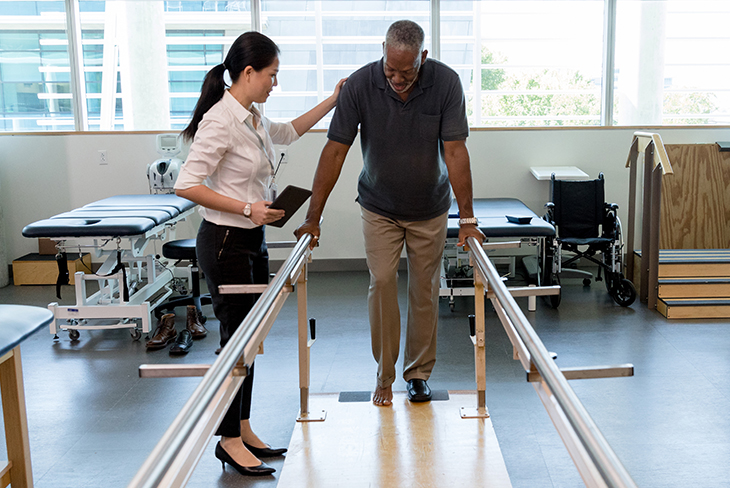Choosing the right stroke rehabilitation centre

Finding the right acute rehabilitation facility, doctors and therapists is imperative to stroke recovery. Here’s what you need to consider.
The coronavirus pandemic has disrupted and dominated healthcare for several months, and doctors and hospitals have expressed concern as evidence mounts that people who are showing signs of a stroke or TIA (Transient Ischaemic Attack) are not seeking urgent medical advice, which could impact long-term recovery.
Rehabilitation is a critical part of the stroke recovery process – without it, patients will struggle to regain the skills that allow them to be independent and confident. But how can you be sure that the stroke rehabilitation facility you’ve selected for your loved one is the right fit?
How do you choose?
Jean’s* husband was admitted to a stroke rehabilitation facility following a debilitating stroke. ‘Although my husband’s ICU doctors recommended the facility, it was severely lacking on many levels. He had also contracted a secondary infection while in hospital, which compromised his recovery even more,’ explains Jean.
She requested her husband be moved and their story ended well, but her experience demonstrates the importance of conducting thorough research before signing into a rehabilitation facility. In fact, there is far more to choosing a facility than a Google search.
Vongani Maboko, rehabilitation consultant at the Life Rehabilitation Unit at Life Riverfield Lodge, says, ‘Proper research is important because it allows the patient to receive the correct treatment related to their diagnosis.’ More than this, he adds, many funders have a specific benefit limit for physical rehabilitation – yet there are some facilities that do not charge a global fee. It is important to choose an acute rehabilitation facility funded by medical aids to access specialised stroke care.
Factors to consider
Keep the following in mind:
- Do they (the acute rehabilitation facility) offer what you need?
- Who is the treatment team?
- Do they have a proven track record?
- Is family involvement encouraged?
- How does payment work?
- Did you get a referral?
Referral request
‘The area, the referring doctor, and the services available are all important,’ says Vongani, but a referral from the hospital where the stroke patient was treated is also key. This ensures that all clinical information submitted to the rehabilitation facility is correct.
Without a referral, you are likely to experience a delay in the time it takes for a patient to be admitted, because the Rehabilitation Admissions Consultant (RAC) needs to pass information on to the funder so that admission can be authorised. In contrast, if a doctor is directly involved, the RAC can liaise with him or her to obtain all necessary information and pass it directly on to the funder.’
Location
Even more important is the comfort and wellbeing of the patient, and how the facility caters for this. If possible, the patient’s family should always be included in the recovery process, which is why location is a key factor – after all, relatives won’t be able to visit frequently if doing so requires complicated or lengthy travel.
Rehabilitation admissions consultant
‘It’s a good idea to visit the facility first so that you can make sure that you are comfortable with the centre,’ Vongani advises. This gives the family a chance to meet the RAC, who is responsible for assessing the patient at the acute facility. He or she also liaises with the funder – to obtain authorisation and establish which benefits are allowed.
The RAC is further tasked with updating the family about all developments, especially decisions around the length of the patient’s stay. In fact, says Vongani, the RAC is the first point of contact you’ll have with the facility, so it’s in your best interests to establish a sound relationship.
Checklist from an expert
What makes a ‘good’ rehabilitation centre? ‘Based on my nursing background, and the years I have spent in the medical-aid industry, I believe this definition hinges on the patient’s needs. The rehabilitation unit should also have an interdisciplinary team that strategically tracks the patient’s progress and ensures they reach their recovery goals, all the while encouraging family involvement,’ Vongani concludes.
What to look for when you’re choosing a rehabilitation facility
- An interdisciplinary team including a rehabilitation doctor, 24-hour nursing staff, social worker, rehabilitation assessor, clinic manager and speech therapist. Some units also offer emotional support through a psychologist and psychiatrist.
- A social worker should act to encourage family involvement.
- Physical training facilities staffed by qualified physiotherapists and occupational therapists
- A fully equipped kitchen and on-site dietitian to cater to the patient’s dietary needs.
- Modified wheelchair ramps are required for wheelchair-bound patients.
- An on-site pharmacy should also be available.
- A clean, hygienic facility.
- A safe, nurturing environment.
Contact a Life Rehabilitation Unit to find out more. All our facilities follow stringent COVID-19 safety measures for patients, staff and visitors.
Eastern Cape
Life St Dominic’s Hospital
043 707 9000; jackie.sparks@lifehealthcare.co.za
Free State
Life Pasteur Hospital
051 522 6601; hannika.struwig@lifehealthcare.co.za
Gauteng
Life Eugene Marais Hospital
012 334 2777; sorita.vantonder@lifehealthcare.co.za
Life New Kensington Clinic
011 538 4700; charlene.kruger@lifehealthcare.co.za
Life Riverfield Lodge
087 352 3765; glynis.krebser@lifehealthcare.co.za
Western Cape
Life Vincent Pallotti Hospital
021 506 5111; vaughanine.johnson@lifehealthcare.co.za
KwaZulu-Natal
Life Entabeni Hospital
031 204 1300; entabeni.support@lifehealthcare.co.za
The information is shared on condition that readers will make their own determination, including seeking advice from a healthcare professional. E&OE. Life Healthcare Group Ltd does not accept any responsibility for any loss or damage suffered by the reader as a result of the information provided.

